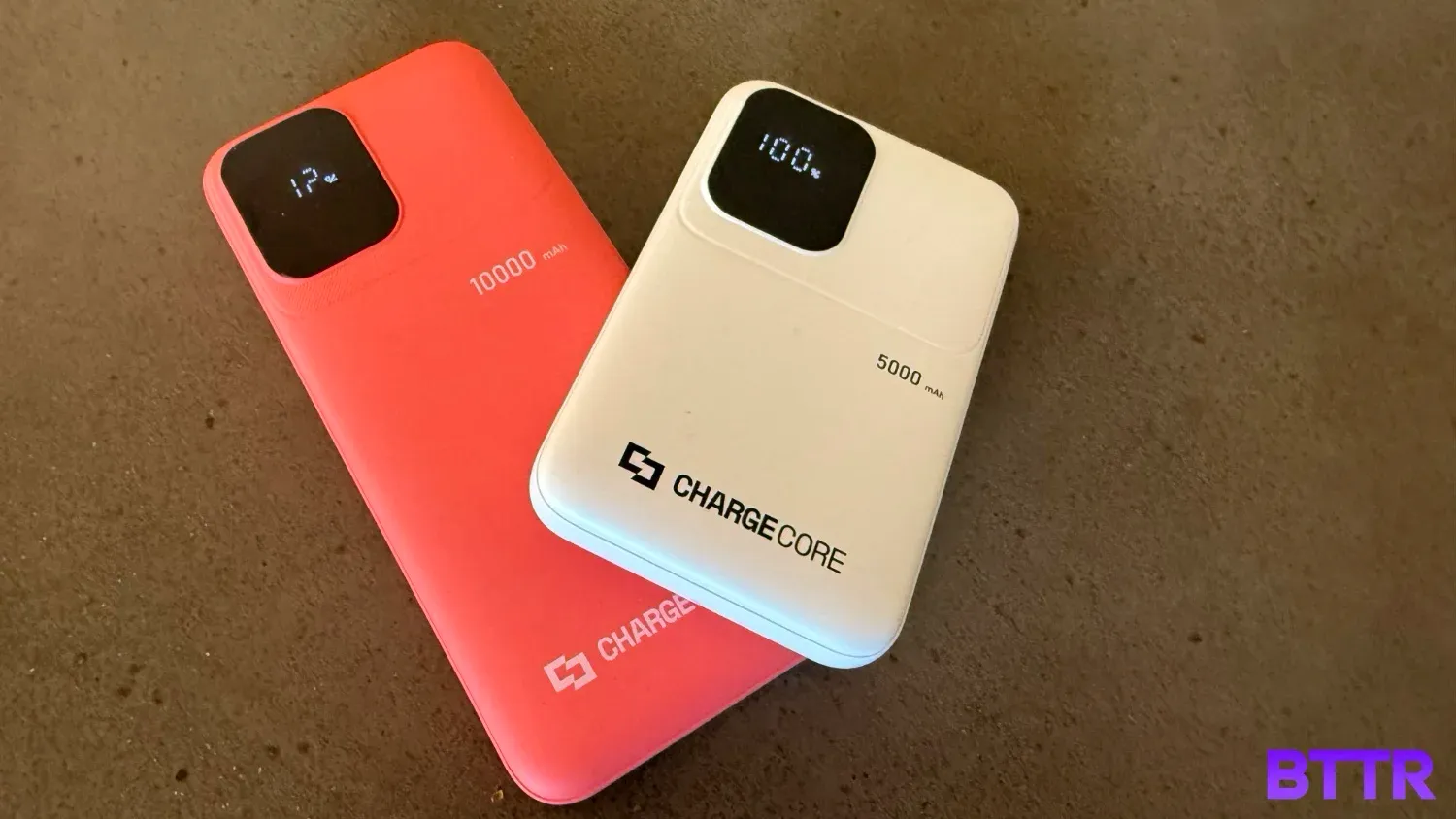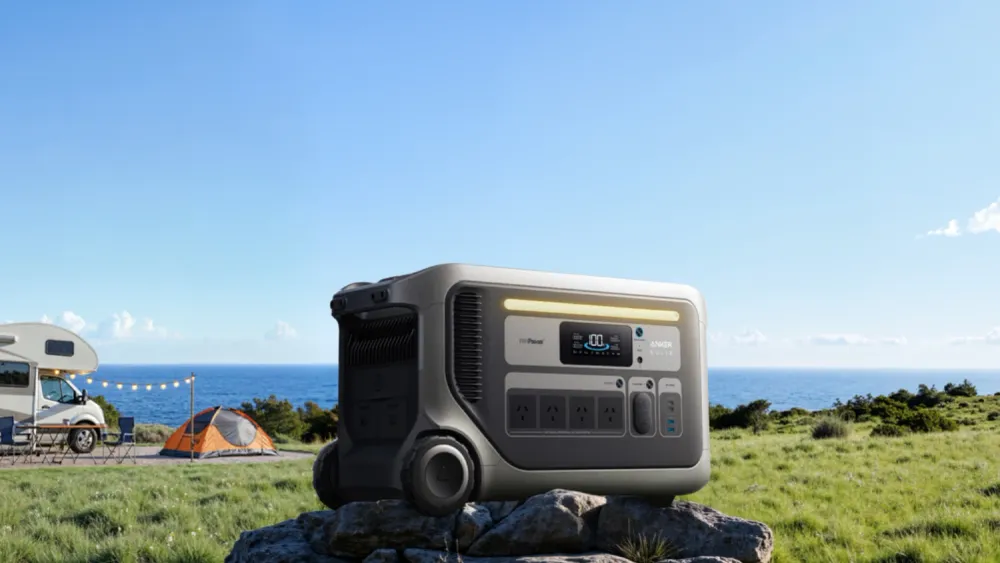Loving...
- Easy to read LCD
- Charge multiple gadgets at once
- Budget-friendly
Meh...
- Only one USB-C port
- Bundled 3-in-1 cable doesn't work with PD20 charging
Not so great...
- 5,000 mAh version not worth it
- Pretty slow charge from USB-A
- Not overly efficient
Laser is an Aussie tech brand well-regarded for offering affordable tech in popular categories, including batteries.
This is an area Laser has some experience in. Last year I reviewed both the larger power station, which did a pretty great job at what it needed to, though its design lacked finesse for the types of people who would want to use it.
I also tested the rugged NRGVault 10,000mAh power bank. It was purpose built for the outdoors thanks to its integrated torch and rugged build.
These new ChargeCore power banks are a bit different from most power banks you get on the market, though. While most portable power banks use Lithium-ion technology, these ChargeCore models use Lithium Iron Phosphate — or LiFePO4 – which offers several advantages over Li-ion batteries.
That’s why, for the most part, your larger power stations use the LiFePO4 technology.
But is there enough of a difference here to make these power banks stand out? I’ve been testing out the 5,000 and 10,000 mAh versions for the past couple of weeks and the answer is clear:
It depends.

What is the ChargeCore LiFePO4 power bank offering?
There are three models in the LiFePO4 ChargeCore power bank lineup: A 5,000 mAh model, a 10000 mAh model and a 20,000 mAh model. They are designed with affordability in mind, with prices starting at $29.95 for 5,000, $49.95 for 10,000 and $69.95 for 20,000 mAh.
That’s pretty good value for money if you just base it on specs. A basic Belkin 10K power bank costs $10 more, as a comparison point.
But the key difference with these ChargeCore models is the battery type. Despite being a bit heavier than your traditional Li-ion battery, these batteries are safer, less prone to overheating and operating in a wider range of temperatures.
They also tend to last longer. Laser promises 5,000 cycles of the battery, where most Li-ion batteries tend to offer more like 1,000 cycles before the battery starts to degrade.
All models come with an old-school integrated LCD that shows the battery capacity, as well as two USB-A ports and a USB-C port, but those ports aren’t all created equally. The 5,000 mAh model’s USB-C port is only for charging the device itself, it won’t output power.
The larger capacities, meanwhile, offer fast charge output up to 20W, which means that they are technically capable of sending juice to a lightweight laptop like the MacBook Air.
In the box, you get a three-in-one USB-A to USB-Lightning/C/C, which lets you charge multiple devices simultaneously. The 5,000 mAh model is limited to simultaneously charging two devices, but because of those output limitations, it’s going to be a slow charge. The two larger models can charge up to three devices at the same time.

How does the ChargeCore LiFePO4 power bank perform?
By opting for LiFePO4 technology, these batteries are less likely to explode and burn down your house while you aren’t looking, so that’s a big win right there.
But performance between the 5,000 mAh and 10,000 was notably different.
Despite having a capacity of 5,000 mAh, the smaller charger only managed to charge a test phone like the Reno13 5G to 50% from a full charge. The Reno 13 has a capacity of 5,600 mAh, so you would expect that from flat it would wind up somewhere closer to 90% full after draining the 5,000 mAh battery.
But it doesn’t.
It was a similar story trying to charge the HMD Pulse Pro, with the 5,000 mAh model taking the phone to 50%.
Which kind of defeats the purpose, right? If the charger can’t even give you a full extra charge of your phone, is it worth buying? Even if it is only $30?
I’d say no.
That said, the 10,000 mAh battery did better. Well, it did better in that it was able to recharge a 5,000 mAh phone from dead to full, with a bit of juice to spare. 11% to be precise - it took 89% of the 10,000 mAh battery to charge a 5,000 mAh battery over a few hours using the USB-A port and the supplied cable.
It can also charge faster than the 5,000 mAh model, thanks to its PD20W spec supporting faster charging speeds.
You get a 3-in-one charging cable in the box, which is handy to have on you, but also limits your charging options in a way. It connects to one of the ChargeCore’s USB-A ports, and lets you plug in either one of two USB-C ports or a Lightning connector.
The catch is that PD20W fast charging on the 10,000 mAh model is limited to the USB-C port, so you need to supply your own cable to take advantage of those faster speeds.

Verdict
As a portable charger, the ChargeCore LiFePO4 chargers do their job, as a compact bit of extra battery life when you need it.
But you get the added benefit of using a technology that is safer, lasts longer and has a convenient display to see exactly how much charge is left.
That said, the chargers aren’t overly efficient, and you lose a lot of the power while charging.
There’s not a huge amount of differentiation in this space, though. If you’re after a portable power bank, then the ChargeCore is a suitable option for its technology choices.
But the 5,000 mAh option, despite its lower price, probably isn’t worth it. It will only charge a typical smartphone about halfway, and lacks the fast-charging capabilities.
BTTR relies on support from readers like you to keep going. If you'd like to support our work, consider a one-time donation. Every little bit helps us to cover costs and stay independent. 100% of donations go directly to authors. Thanks for your support!
Behind the scenes:
Compare the models
| Feature | 5000mAh Powerbank | 10000mAh Powerbank | 20000mAh Powerbank |
|---|---|---|---|
| Battery Capacity | 5000 mAh (16Wh) | 10000 mAh (32Wh) | 20000 mAh (64Wh) |
| Battery Type | LiFePO4 | LiFePO4 | LiFePO4 |
| Product Dimensions (L x W x H) | 6.6 x 1.5 x 10 cm | 6.6 x 1.5 x 15 cm | 6.6 x 2.5 x 15 cm |
| Product Weight | 0.126 kg | 0.216 kg | 0.396 kg |
| Powerbank Charging Port | USB-C | USB-C | USB-C |
| Powerbank Input | 5V/2A | 5V/3A, 9V/2A, 12V/1.5A | 5V/2A |
| Device Charging Ports | 2 x USB-A | USB-C, 2x USB-A | USB-C, 2x USB-A |
| Device Output | USB-A: 5V/2A | USB-C: 5V/3A, 9V/2.22A, 12V/1.67A; USB-A: 5V/3A, 9V/2A, 12V/1.5A, 10V/2.25A |
USB-C: 5V/3A, 9V/2.22A, 12V/1.67A; USB-A1/A2: 5V/3A, 9V/2A, 12V/1.5A, 10V/2.25A |
| Fast Charging | No | Yes | Yes |
| Simultaneous Charging | Yes | Yes | Yes |
| LED Display | Yes | Yes | Yes |
| Operating Temperature | 0-35℃ | 0-35℃ | 0-35℃ |
| Case Material | ABS V0+ | ABS V0+ | ABS V0+ |
| Built-in Protections | NTC, Over-charging, Over-heating | NTC, Over-charging, Over-heating | NTC, Over-charging, Over-heating |
| Battery Charging Time (0-100%) | Up to 3 hours (with 10W wall adapter) | Up to 2.5 hours (with PD wall adaptor), Up to 5 hours (with 10W wall adapter) | Up to 5 hours (with PD wall adaptor), Up to 8 hours (with 10W wall adapter) |
| Cable Length | 30 cm | 30 cm | 30 cm |
| What's in the Box | Powerbank, 3-in-1 USB-A to USB-C/Lightning/Micro USB cable, User manual | Powerbank, 3-in-1 USB-A to USB-C/Lightning/Micro USB cable, User Manual | Powerbank, 3-in-1 USB-A to USB-C/Lightning/Micro USB cable, User Manual (Inferred) |
Additional thoughts
- I was playing Breath of the Wild on my OG Switch (I still don’t have the Switch 2, sadly) and hit the point where the battery got down to 1%. It just so happened to be at the point I was trying to complete the Vah Naboris Divine Beast, and wasn’t quite ready to stop playing. I plugged in the 5,000 mAh ChargeCore unit, and it let me keep playing for another 20 minutes until I finished the mission, though the charge never rose above that 1% mark.
- I feel like we’re at a point where USB-C ports should be the dominant connector, rather than USB-A. Having two A ports and a single C (which you need to use for charging the device as well), seems like an outdated approach.
Tips and tricks
- If you do end up with one of the bigger ChargeCore models, make sure you use the USB-C port to charge your gadgets. It offers faster charging speeds and is typically more efficient as well.
- Laser claims that the LiFePO4 batteries are classified safe for air travel in your carry-on, but I can't find evidence of that. While LiFePO4 batteries are arguably safer than Lithium-ion batteries, all evidence indicates they are still treated the same when it comes to flying, which means that these models must be carried in checked baggage, rather than your carry-on. Even if technically you can take in it carry-on, there's no clear indication on the device itself it uses LiFePO4, so expect to be asked to pack it away, anyway.





